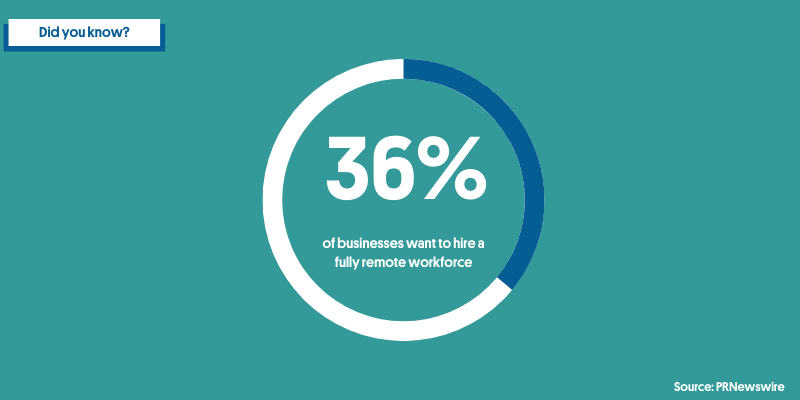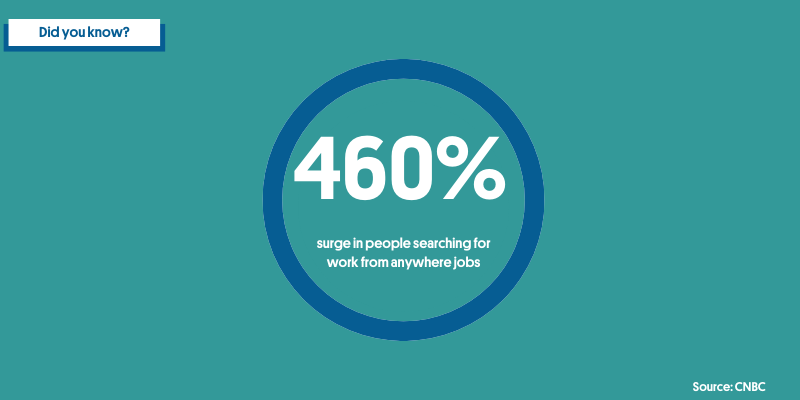All You Need to Know About Remote Work and the Hire From Anywhere Model

One survey found that after COVID-19, 36% of companies are willing to hire a 100% remote workforce either in the United States or internationally. Before COVID-19, that percentage was only 12%.

Many companies have seen that being able to hire internationally and have a fully remote team benefits their business, and more companies are adopting this model. However, that doesn’t mean it’s easy to adopt immediately. It may also not be a good fit for every company out there.
But there are undeniable benefits to consider, especially when considering the future trends of remote work. Keep reading to know everything about how to hire from job markets anywhere.
Rise of Remote Work
Before the pandemic, a handful of companies had employees working remotely. However, after COVID-19 threatened the health of all employees in the office, many companies sent their employees with a laptop and instructions to work from home.
Two years later, companies are now struggling to bring employees back into the office. Many employees enjoyed the benefits of remote work so much that they quit jobs and searched for fully remote jobs. The pandemic caused a 460% surge in people searching for work from anywhere jobs.

This left companies with a decision to make. Did they want to drag employees back into the office, offer a hybrid model, or go fully remote? Many companies couldn’t deny the benefits of having a fully remote team, but they also couldn’t deny that there were still challenges.
Challenges of Hiring Remote Workers from Anywhere
If you’re interested in adopting this model, you might wonder where you can find that talent. And how do you bring them onto your payroll? How do you keep track of all the rules and regulations different countries have regarding the hiring process? Thankfully, there are solutions out there, like Deel, that can help you manage your workforce around the globe. With 1,100 people employed in 75 different countries, Deel knows how complex these challenges can be, and they want to make it easier for any company to hire from anywhere.
There is also the challenge of hiring employees across different time zones. For example, you may find the best candidate in Japan if you’re a US-based company. However, that means they’re working on drastic time zone differences from your headquarters. This problem doesn’t mean you can’t make your business work on a remote model. This is why many companies are adopting an asynchronous work schedule.
If you need employees to be on the same schedule, you can specify a time zone in work from anywhere job description. However, keep in mind that this will limit the number of applicants eligible for that position.
You might also find it difficult to train a fully remote team. It can be challenging to get them up to speed on all of your services and products through online tutorials and live video training. However, you need to adjust the tactics of your onboarding strategy. You might need to increase the training timeline or have video conference training.
Benefits of Hiring Anywhere
While these challenges are essential to consider, there are many benefits to being able to hire talented employees from any country. For example, you’ll get access to more talent.
According to Deel’s State of Global Hiring Report, the hire rate in Latin America has grown by 286%. Many companies realize that this is one of the untapped talent pools in the world, and the labor is also more affordable for small businesses or startups.
In addition to finding great talent, you’ll be able to offer remote flexibility. You can create a culture of trust and engagement with your employees when you have flexibility.
Hiring from around the world will also naturally grow your workforce and make it more diverse. When you have employees from all over the world, you’ll bring fresh perspectives that can grow your business and make it successful. Having a diverse workforce can also boost your employer’s brand and make your company more attractive to potential remote job seekers.
Speaking of your brand, it will also make you more attractive to customers. With employees all around the world, you can better represent the customers that you serve. You’ll also be able to meet the customer where they are and better provide products or services that they need. Plus, there is a strong correlation between having your employees engaged internally and also engaging your external customers.
To hear more about the benefits of hiring employees around the globe, check out this webinar hosted by Jennifer Goodfriend, VP of enterprise sales at Recruiter.com, and Casey Bailey, head of internal people at Deel.
Trends in Remote Work
During the webinar, Goodfriend and Bailey also discussed the trends in remote work. Both had noticed that many of their US-based clients had seen an increase in hiring in Latin America. However, many companies are hiring in the Asian Pacific and Pakistan as well.
In addition to being able to hire team members from anywhere, the salaries are also increasing to keep up with this demand. Mexico saw the most significant salary increase, with an average of 57%.
While remote work is excellent and offers employees flexibility and work-life balance that they didn’t have before, many of them still want a human connection and interaction. However, they don’t want to go into the office five days a week. This is why many companies are shifting towards a hybrid model, but this can be challenging while also hiring from anywhere. To address this problem, Recruiter.com and Deel have partnered with WeWork to allow their remote employees to take advantage of a coworking space whenever they need to get out of the house or hold in-person meetings with customers or coworkers.
In addition, the Job Hopper Economy is also becoming a more significant trend with remote work. Now, employees have expectations of getting advancements or promotions. They want to feel like they’re progressing in their career; if they’re not, they will look for a higher position at a different company.
The expectation in the workplace is changing. Depending on an employee’s industry, they may only stay for a year or two before looking for a new position.
Evan Sohn, CEO of Recruiter.com, also talked about the Job Hopper Economy. He mentioned that workers no longer feel the need to stay at their company for a certain length of time: “With the rise of work from anywhere, hire from anywhere, and an easier interview process all done virtually, there’s no reason for employees not to be looking for a better opportunity.”
The Future of Remote Work
Both Goodfriend and Bailey agreed that remote work is here to stay, in some capacity. There will still be some companies that need to have employees in the office because of job limitations. However, for the companies that can hire from anywhere, they should take advantage of it. Many of them are.
Experts predict that 25% of professional jobs will be fully remote by 2022. They also anticipate that the level of remote employment will rise in 2023.
If your business isn’t adapting to flexible schedules, remote work, or considering hiring from anywhere, you may get left behind in the race for global talent. To learn more about how you can hire the best talent, contact us today.
Get the top recruiting news and insights delivered to your inbox every week. Sign up for the Recruiter Today newsletter.
